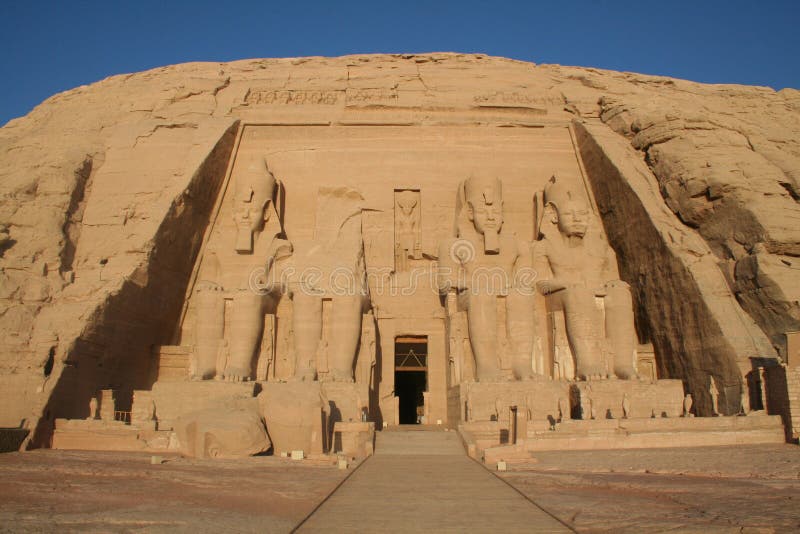Abu Simbel is an archaeological site comprising two massive rock temples in southern Egypt on the western bank of Lake Nasser about 290 km southwest of Aswan. It is part of the UNESCO World Heritage Site known as the Nubian Monuments, which run from Abu Simbel downriver to Philae (near Aswan). The twin temples were originally carved out of the mountainside during the reign of Pharaoh Ramesses II in the 13th century BC, as a lasting monument to himself and his queen Nefertari, to commemorate his alleged victory at the Battle of Kadesh, and to intimidate his Nubian neighbours. However, the complex was relocated in its entirety in the 1960s, on an artificial hill made from a domed structure, high above the Aswan dam reservoir. The relocation of the temples was necessary to avoid being submerged during the creation of Lake Nasser, the massive artificial water reservoir formed after the building of the Aswan dam on the Nile River. Abu Simbel remains one of Egypt's top tourist attractions. Construction of the temple complex started in approximately 1284 BC and lasted for circa 20 years, until 1264 BC. Known as the Temple of Ramesses, beloved by Amun, it was one of six rock temples erected in Nubia during the long reign of Ramesses. Their purpose was to impress Egypt's southern neighbours, and also to reinforce the status of Egyptian religion in the region. With the passing of time, the temples became covered by sand. Already in the 6th century BC, the sand covered the statues of the main temple up to their knees. The temple was forgotten until 1813, when Swiss orientalist JL Burckhardt found the top frieze of the main temple. Burckhardt talked about his discovery with Italian explorer Giovanni Belzoni, who travelled to the site, but was unable to dig out an entry to the temple. Belzoni returned in 1817, this time succeeding in his attempt to enter the complex. The temple was relocated in 1968.
圖片編號:
31315489
拍攝者:
Imagineimages
點數下載
| 授權類型 | 尺寸 | 像素 | 格式 | 點數 | |
|---|---|---|---|---|---|
| 標準授權 | XS | 480 x 320 | JPG | 13 | |
| 標準授權 | S | 800 x 533 | JPG | 15 | |
| 標準授權 | M | 2121 x 1414 | JPG | 18 | |
| 標準授權 | L | 2738 x 1825 | JPG | 20 | |
| 標準授權 | XL | 3464 x 2309 | JPG | 22 | |
| 標準授權 | MAX | 5060 x 3373 | JPG | 23 | |
| 標準授權 | TIFF | 7156 x 4770 | TIF | 39 | |
| 進階授權 | WEL | 5060 x 3373 | JPG | 88 | |
| 進階授權 | PEL | 5060 x 3373 | JPG | 88 | |
| 進階授權 | UEL | 5060 x 3373 | JPG | 88 |
XS
S
M
L
XL
MAX
TIFF
WEL
PEL
UEL
| 標準授權 | 480 x 320 px | JPG | 13 點 |
| 標準授權 | 800 x 533 px | JPG | 15 點 |
| 標準授權 | 2121 x 1414 px | JPG | 18 點 |
| 標準授權 | 2738 x 1825 px | JPG | 20 點 |
| 標準授權 | 3464 x 2309 px | JPG | 22 點 |
| 標準授權 | 5060 x 3373 px | JPG | 23 點 |
| 標準授權 | 7156 x 4770 px | TIF | 39 點 |
| 進階授權 | 5060 x 3373 px | JPG | 88 點 |
| 進階授權 | 5060 x 3373 px | JPG | 88 點 |
| 進階授權 | 5060 x 3373 px | JPG | 88 點 |











 +886-2-8978-1616
+886-2-8978-1616 +886-2-2078-5115
+886-2-2078-5115






